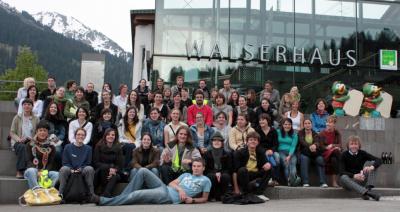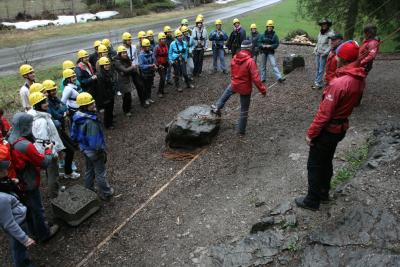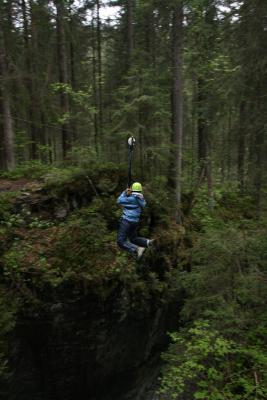morning:
World café – borders of sustainable creation
"The beginning of the fourth day in Kleinwalsertal for the participants of the ELASA mini-meeting started a little bit secretly, it looked like organizers didn’t want to show us whole cards for the day, but enough to tickle our curiosity to know what is behind very various but interesting lectures.
The topic of the fourth day was world café -borders of sustainable creation. The invited experts, who were from different professions, showed us that the border topic could be observe as an interdisciplinary problem. It isn’t every border visible, strict political or geographical, there are some menthal invisible borders; some borders are marker of different land use and some are just area of contacts of people.
The morning program was divided into several seven minutes (plus three minutes for questions) sections:
Peter Arlt, a sociologist, in the first seven minutes showed us a great innovative approach to problems of people in village or open public space.
In the next seven minutes
Andreas Rumpfhuber, an architect, showed us through diagrams interesting way of people’s communication in work spaces, some kind of hierarchy, who should deal with whom in the work space.
Kristina Keβler and Elisabeth Gruber, geographers, introduced us in their seven minutes section with hazard avalanches in Klainwalsertal region.
Sybille Zech, a spatial planner, gave us a brief seven minutes introduction to her study and study of her team about sustainable development of landscape in villages of Kleinalsertal.
Julia Empter, landscape ecologist, spoke seven minutes about dealing with sustainable development in Alps. Also she introduced us with very interesting method of observing landscape’s changing, by watching and comparing old pictures and nowadays pictures of the same spot in the landscape.
And very last seven minutes were dedicated to
Ralo Mayer, an artist, who talked about sounds on the borders.
After those rapidly forty two minutes plus more or less eighteen minutes for questions, came the time for the activations. Those activations as usually were very amusing.
After Flo’s gong we had task to find free chair for one of several tables in the room. Each table had chair leader, actually one of mentioned expert, who waited us to start discussion with him or her about assigned questions. The questions were of various ranges, but the point was to sort some toponyms in our heads observed again from different fields of professions and maybe to gain some results for the assigned topic.
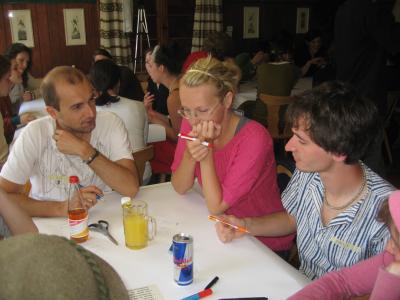
After twenty minutes of discussing and wising with one exert, Flo’s gong reminded us that we should change the table and to exchanged knowledge with other table group.
It was really interesting to realize that our work as landscape architects with the borders, as a topic, could be expanded in such big scale through sociology, architecture, spatial planning, geography, ecology, also art.
So, step by step organizers wanted to lead us into the border topic and its problems and to allow us to find the most adequate solutions, with great help of mentioned experts, of approaching to sustainable landscaping of borders. Whole day had some gradation spirit. First step was joining experts into problems of the borders, second step was amusing activation and then we split into groups for afternoon workshop with same experts. In order to that, whole secretly morning was in due to make some kind of entrance for afternoon workshop “exploration”. The secret is revealed.
At the end we got great and creative results about borders thanks to so many and various aspects of view.
Landscape architecture, actually landscape architects with landscape planning wants to reach harmonization of land use in one region, what is more to reach sustainable maintaining of landscape in ecological and economy way. Sometimes in that attempt to reach the aims landscape architects are emphasizing the nature and its importance, but other aspects are neglected, such people, tradition, architecture, sensual perception.
This fourth day in Kleinwalsertal each of us helped, after all, to became richer for one extra skill to approach the problem in extensive, sustainable, also imaginative way."
Ivana Blagojevic, Serbia
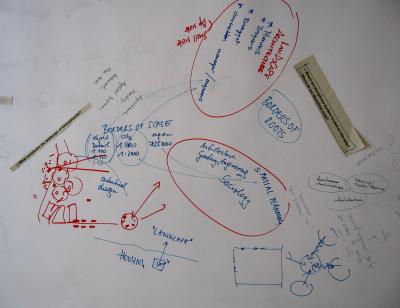
afternoon:
Workshops - exploration
approach: architecture
guest: andreas rumpfhuber, vienna
"Our group was lead by an architect Andreas Rumpfhuber. It consisted of 8 persons, each from a different country.
The workshop took place in the interior of the local church in Kleinwalsertal. Our task was to observe all the elements and processes that occurred on the spot, and to record them in form of diagrams.
Different kinds of information were gathered, such as circulation and distribution of different categories of users, feelings and impressions, spatial zones with different functions and so on. While being in church, we were not allowed to speak to the others from the group, in order not to disturb actual feeling and ambience. At the same time we were observers who stood aside, and the actors, as we recorded not only other people’s behavior and movement but ours as well.
We stayed in church for half an hour, after which we gathered to discuss the results and create diagrams that were intended to present the outcome of the work (picture).
What we documented was the everyday life of the church. The holiness of its ambience was replaced with daily activities of the regular users. There was a man engaged with cleaning and maintaining the church, an old lady occupied with replacing dried flowers, us, and tourists. Each group had a different space consuming pattern related to the meaning the church has for them.
The methodology we used to explore the inner space of the church could be easily used for the outdoor space. According to the diagrams we drew, interior of the church is segmented into two distinctive areas, private (sacred) one and public one, and such segregation is common for the outdoor space as well. Space of the church is layered in meaning. It is a holly place for those who pray to God, a home for cleaner and the old lady, a historical and cultural site for tourists, an experimental place for us. The same is with the open space, where every user has its own preferences and different specific way of space utilization. "
Slavica Cepic, Serbia
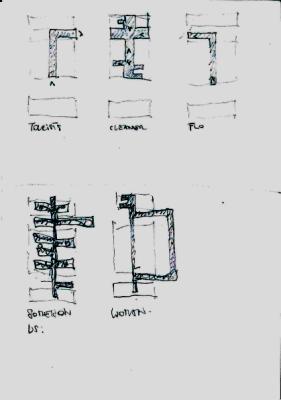 approach: art
approach: art
guest: ralo mayer, vienna
"...At the beginning everything was very dizzy...
We started observing Kleinwalsertal and told to each other what we see in the landscape and what relations or emotions rose up: Mountains with snow, music ... Melody of Happiness, village of roofs, monsters, theatre, evanescence. To mix it with reality we laid down and took a look at the village upside down. Now it seemed like a collage of blue and green.
Ralo came up with an idea to acquaint our new ideas to someone. We found our victim- she was a lady working at the marketing desk where she sold tourist staff related to Kleinwalsertal.
One group decided to act landscape architects who are well sponsored by russian investors and want to introduce their new planning ideas related to Kleinwalsertal. Cutting trees to plant them so that it makes the name of the village (example of Hollywood), greenhouses instead of nature. All that to give more identity to the village.
Other group acted as moviemakers from "Europictures Film LTD" company (based in London) who wanted to find out if Kleinwalsertal is suitable for their project. The group told her that they are on a sight spotting tour through Swiss and Austrian valleys and wanted to know, if there is any infrastructure available, as this is the first film here. They wanted to know if it´s possible to close the main street for tanks they will use for a science fiction movie. They wanted to use genetic modified plants and animals (cows and bears).
The marketing lady´s reaction was unpredictable- the woman who had to listen to all our ideas was attracted. She encouraged us and was even interested in our ideas. 5 Points!
When the second group came in, she already was suspicious of our doings. She realized that it might be a game. But after a while she came more talkative, specially when she could talk about her projects. She tryed to help us as much as she could.
As Ralo pointed out that in a way we gave for the shop a reflection effect- isn´t what tourism is all about- selling of hyperbole ideas!
Must say that it was very inspiring workshop and one of a kind experience. And now Im interested in lending a science fiction movie!"
Häli-Ann Tooms, Estonia
 approach: ecology
approach: ecology
guest: julia empter, CIPRA-germany
"This workshop was conducted by Julia Empter and started in front of our accommodation. Every student received five copies of landscape photographs, which were taken in Kleinwalsertal in the beginning of the 20th century. Within a two hours hiking tour we located the places the pictures were taken from and made new one with the same line of vision. We compared the old pictures with the reality and discussed visual changes and their reason. There was always the question if these parts of the landscape are still natural and how much did they change by anthropogenic influence. In the end of the workshop we digitalized our pictures and presented our studies to the rest of the group. "
heiko ruddigkeit, germany, organisation team
 approach: geography
approach: geography
guests: Elisabeth Gruber and Kristina Keßler
"We have all started working at the directly explaining our theme – protection of people against natural dangers in mountains. Kleinwalsertal has many of examples whitch some of them we saw immediately on our small tour around the valley. Walking „natural“ road, spoking about disasters and their hystorical beackground explored the thema of disasters, their impact on nature and people.
People wants to be in a safety, living without stress of losing their lives and society follows everything to to reach it. Life in mountains was observed in last 50 years .. avalanches and wind storms endangered their lifes, although incoming people didn't know enough about danger abowe their heads and settled in areas which were in danger even they know about danger what may come, they overstep invisible border between safety and unsafety areas. Geographical research of endangerd area is proposed from disasters which alredy happend. Endangered areas are still not enough respected. Nowardays are many protectional barriers built in high places and whole countryside is for peoples safety changes. There is no more genuine nature."
Pavol Meszaros, Slovakia
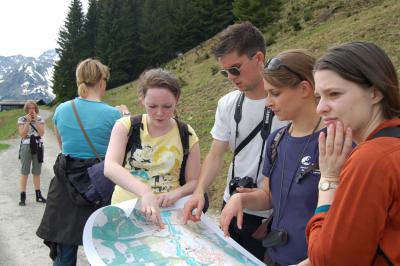 approach: sociology
approach: sociology
guest: peter arlt, linz
"Our group attended the Saturday workshop with sociologist Peter Arlt. After a short trip, where we visited the surrounding, we came to a village, Hirschegg, a part of Kleinwalsertal. There a surprise was waiting for us; the excursion to a factory for production of artificial snow. Our guide showed to us big machines for snow production, equipment of the factory and specific software. After this visit, the principles of process of making artificial snow were explained.
During our trip home, the question was put - is it necessary to produce artificial snow? Is it economic? And ecological? Is really the economic aspect more important than the protection of nature? What is the difference between artificial and natural? Does genuine nature still exist, at all? Everything is reformed by man…
This one and also other insolvable question were thought out."
Marie Gelova, Czech Republic
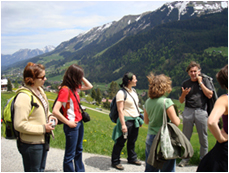
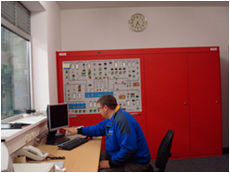 approach: spatial planning
approach: spatial planning
guest: sibylla zech, vienna
"The topic of the session was spatial planning with Sibylla Zech. It was about the planning of residential places, example was the village Mittelberg. The workshop concerned the urbanization plan, designed eight years before and its actual consequences. The main topics concerned the places self-sufficiency, structure and problems.
Mittelberg is a small nice city with well-developed tourism. The designed spatial plan is working great after 8 years. The main problem is the missing shopping and service area, which is important for the habitants and the tourists. The infrastructure is situated mainly in the centre. There is a church, fire department, theatre and café. The shopping area existing before is only an empty space now.
One of the spots marked as a place with degradation problems on the map is an existing gravel pit, visible for everyone. The group made a visit to it and the pit was really visible for everybody and did not look good.
After all the conclusion after today’s workshop we can say that Sibille Zech and her team did great work before, that we can see its beauty today. "
Valentina Taligarova, Bulgaria
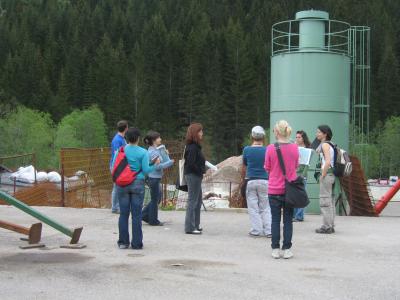
platzregen - 24. Mai, 20:54




